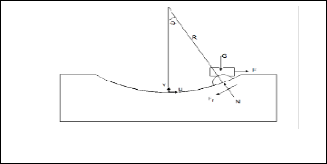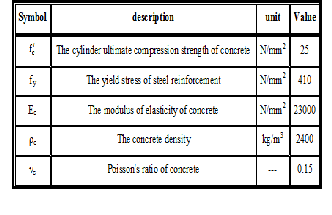
International Journal of Scientific & Engineering Research, Volume 5, Issue 9, September-2014 939
ISSN 2229-5518
Finite Element Analyses of Seismically Isolated
Buildings with Variable Geometric Configurations
Dr. Haider S. AL-Jubair, Fareed H. Majeed
Abstract— Multi-story hypothetical reinforced concrete buildings of variable geometric configurations (symmetrical, vertically irregular, horizontally irregular); with fixed base and isolated bases via high damping rubber bearing and friction pendulum systems, are analyzed by using finite element method under seismic load function (North-South component of the ground motion recorded at a site in El Centro, California in 1940). The bilinear hysteretic model of base isolation system and the Rayleigh damping framework for superstructure are adopted. It is proved that, the base isolation is very effective technique in reducing the earthquake responses and that, the friction pendulum system is more efficient in reducing the earthquake responses compared to the high damping rubber bearing isolators of the same design displacement and fundamental period. Also, the results showed that, the isolators still highly effective in reducing the earthquake responses for the horizontally and vertically irregular buildings. The twist due to the horizontal irregularity is magnified due to the presence of isolators, especially for the friction pendulum system.
Index Terms— Multi-story, vertically irregular, horizontally irregular, isolated building, friction pendulum, high damping rubber bearing, seismic, finite element

Tisolation systems.
—————————— ——————————
he concept of passive base isolation has two basic types of
1-The system that uses elastomeric bearings. In this ap- proach, the building is decoupled from the horizontal compo- nents of the earthquake ground motion by interposing a layer with low horizontal stiffness between the structure and the foundation.
2-The system that uses sliding. In this approach, the system is limiting the transfer of shear across the isolation interface by using sliders or rollers between the structure and the founda- tion.
In this paper the two isolator types that are representative of sliding and elastomeric systems will represented by the Friction Pendulum System (FPS) and the High Damping Rub- ber Bearings (HDRB), respectively.
The buildings are modeled using the finite element meth- od. The force-deformation behavior of the two systems of iso- lators is modeled as non-linear hysteretic represented by the bi-linear model as shown in Fig. 1. The isolator is modeled using six springs. The springs for three of the deformations: axial, shear in the x-z plane, and pure bending in the x-z plane are shown in Fig. 2. The hysteretic models for bearings is used to account for all the energy dissipation and the viscous damping using the Rayleigh damping framework is used for the superstructure.
Fig. 1. Parameters of basic hysteresis loop of an isolator for bilinear modeling [1].
————————————————
• Fareed H. Majeed is currently pursuing Ph.D degree in civil engineering in
Basrah University, Iraq. E-mail: fhmfareed@gmail.com
Fig. 2. Three of the six independent springs in a Link/Support element [2].

The geometric configurations of the superstructures are shown in Fig. 3. A (150 mm) thick slab is considered with (400 mm x 600 mm) beam typical sections and column size of (600 mm x 600 mm).
IJSER © 2014
International Journal of Scientific & Engineering Research, Volume 5, Issue 9, September-2014 940
ISSN 2229-5518
5 Spans @ 5 m = 25 m

The reinforced concrete buildings are analyzed for dead, live and earthquake functional loads. The minimum design dead load on each floor consists of loads due to floor slab, beams, columns and portion walls. The floor live load is taken as (3 kN/m²) and the roof live load is taken as (1.5 kN/m²). The North-South component of the ground motion recorded at a site in El Centro, California in 1940, shown in Fig. 4, is ap- plied to the building. All of the dead load and only (25%) of the live load is considered in the seismic analysis [IBC 2012] [3].
a. Plan of symmetrical building
Figure 4 El Centro, California in 1940 earthquake [4].
b. Section of symmetrical building.
c. Section of the vertically irregularity building.
d. Plan of the horizontally irregularity building.
Fig. 3. The geometric configurations of the superstructures.

The isolators are designed according to the procedures de- scribed in the UBC-97 [5]. The characteristics of high damping rubber bearing system are illustrated in Fig. 5 whereas, the mechanism of friction pendulum system is shown in Fig. 6.
Fig. 5. The characteristics of high damping rubber bearing: a. High damping rubber bearing used in the earthquake simulator tests with dimensions in mm; b. Corresponding force- deformation hysteresis [6].
Fig. 6. Mechanism of the friction pendulum system [7].
IJSER © 2014 http://www.ijser.org
International Journal of Scientific & Engineering Research, Volume 5, Issue 9, September-2014 941
ISSN 2229-5518
The characteristics of superstructure materials and the de- sign parameters of the isolation systems are summarized in Tables 1 and Table 2.
The responses of buildings, with different base conditions, in terms of total base shear are shown in Fig. 7, 8 and 9.
TABLE 1
THE SUPERSTRUCTURE MATERIAL PROPERTIES.

TABLE 2
DESIGN PARAMETERS OF ISOLATORS.

All buildings are solved using the nonlinear direct integra- tion method for fixed base and isolated bases using the high damping rubber isolation and friction pendulum systems.
The modal periods and frequencies of the free vibration analyses of buildings are shown in Table 3.
Fig. 7. Total base shear for symmetrical building.
TABLE 3

DESIGN PARAMETERS OF ISOLATORS.
IJSER © 2014 http://www.ijser.org
Fig. 8. Total base shear for vertically irregularity building.
International Journal of Scientific & Engineering Research, Volume 5, Issue 9, September-2014 942


ISSN 2229-5518
Fig. 9. Total base shear for horizontally irregularity building.
Fig. 11. Maximum acceleration for vertically irregularity building.

It is evident that, the total base shear is reduced in isolated buildings compared to the fixed base building. The friction pendulum system is more efficient than high damping rubber bearing base and decreases of about (95%) and (75%), respec- tively are recorded. This can be attributed to the geometry of friction pendulum isolator [the radius of curvature (R)], tend- ing to restore the structure according to the gravity effect.
The maximum acceleration time histories for the fixed and isolated buildings are shown in Fig. 10, 11 and 12.
Fig. 12. Maximum acceleration for horizontally irregularity build- ing.
Fig. 10. Maximum acceleration for symmetrical building.
It is clear that, the values are magnified for the fixed base building compared to the input earthquake. The maximum acceleration responses for both isolated buildings are nearly identical and a decrease of about (62%-80%) is recorded com- pared to the fixed base building.
IJSER © 2014 http://www.ijser.org
International Journal of Scientific & Engineering Research, Volume 5, Issue 9, September-2014 943
ISSN 2229-5518


The maximum relative displacements (displacement with respect to displacement of base) for the fixed and isolated base buildings are shown in Fig. 13, 14 and 15.
Fig. 13. Maximum relative displacement for symmetrical build- ing.
Fig. 14. Maximum relative displacement for horizontally irregular- ity building.
For the symmetrical building, the maximum relative dis- placements of both isolated buildings are almost the same and a reduction of about (90%) is observed compared to the fixed base building.
The maximum relative displacements are almost unaffected by the vertical irregularity, for the fixed base and rubber bear- ing base buildings. A slight asymmetric (positive increase and negative decrease) behavior is recorded regarding the friction pendulum isolated base building.
The horizontal irregularity, produced no effect on the rela- tive displacement, for the fixed base building and minor a ef- fect on the high damping rubber bearing isolated base build- ing. The displacement is greatly reduced, for the friction pen- dulum isolated base building, due to the horizontal irregulari- ty.
Fig. 14. Maximum relative displacement for vertically irregularity building.
Fig. 15 shows the rotation of the center of mass about z- axis
in the five stories due to the building irregularities for the var-
ious base conditions.
For the vertically irregular building, inclusion of high
damping rubber bearing reduced the rotation above the first
story. The friction pendulum isolators reduced the rotation at
the top story only. The increase in rotation is ceased beyond
the second story for the isolated buildings.
For the horizontally irregular building, inclusion of base
isolators increased the rotation especially for the friction pen-
dulum type. The increase in rotation is ceased beyond the first
floor for the high damping rubber bearing and the third floor for the friction pendulum isolators.
IJSER © 2014 http://www.ijser.org
International Journal of Scientific & Engineering Research, Volume 5, Issue 9, September-2014 944
ISSN 2229-5518
a. Vertically irregular
b. Horizontally irregular
Fig. 15. Maximum rotation of the center of mass in the isolated building stories.

[1] Jena K., (2006), “Pasive Vibration Control of Framed Structures by Base Isola- tion method Using Lead Rubber Bearing”, Master of Technology in Structural Engineering, thesis, National Institute of Technology, Rourkela.
[2] .CSI Analysis Reference Manual (2011), for SAP2000, ETABS, SAFE and
CSiBridge.
[3] International Building Code 2012, (2011), International Code Council, INC.
USA.
[4] Chopra A., (2007), “Dynamics of structures, theory and applications to earth- qua ke engineering”, 3rd edition, Upper Saddle River, New Jersey, 876 PP.
[5] .Naeim F. and Kelly J., (1999), “Design of Seismic Isolated Structures: From
Theory to Practice”, John Wiley & Sons, Inc, 289 pp.
[6] .Higashino M. and Okamoto S., (2006), “Response Control and Seismic Isola- tion of Buildings”, published by Taylor and Francis (USA), 484 pp.
[7] .Uniform Building Code 1997, Vol.2, Structural Engineering Design Provi- sions, USA.
1. Base isolation is very effective technique in reducing the earthquake responses represented by the base shear, max- imum acceleration, and maximum relative displacement.
2. The friction pendulum system is more efficient in reducing the earthquake responses compared to the high damping rubber bearing isolators of the same design displacement and fundamental period.
3. Vertical irregularity has minor effects on the efficiency for the base shear, maximum acceleration, and maximum rela- tive displacement for the isolated buildings. Unlike the friction pendulum, the high damping rubber bearing isola- tor reduced the twist compared to the fixed-base.
4. The isolators have high efficiency in reducing the base shear and the maximum acceleration for the building with hori- zontal and vertical irregularity. It produces considerable decrease in the maximum relative displacement for the friction pendulum base isolated structure. The twist is magnified due to the presence of isolators, especially the friction pendulum system.
IJSER © 2014 http://www.ijser.org